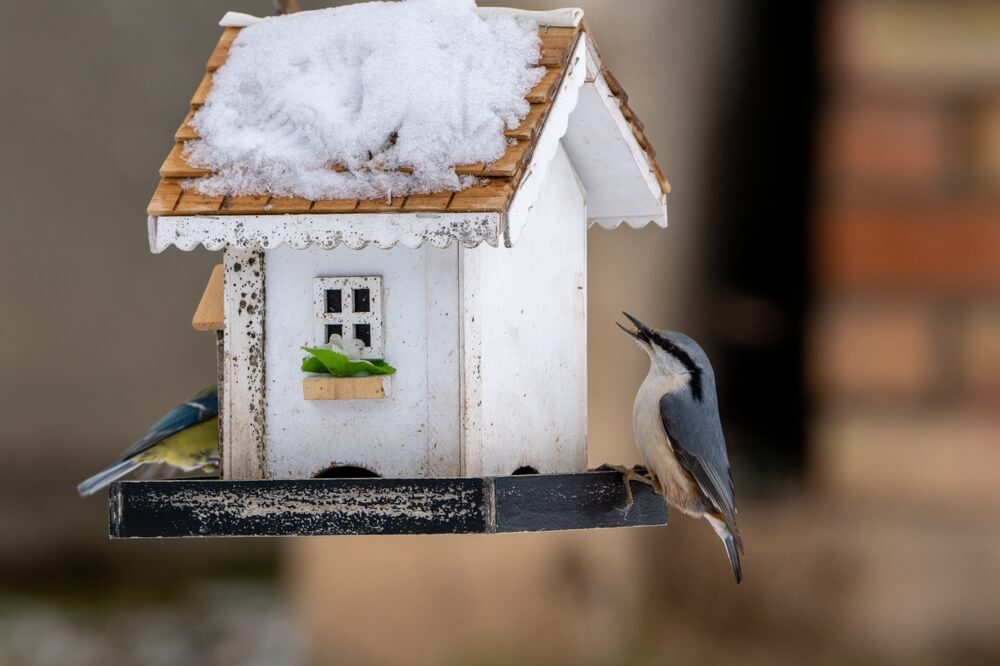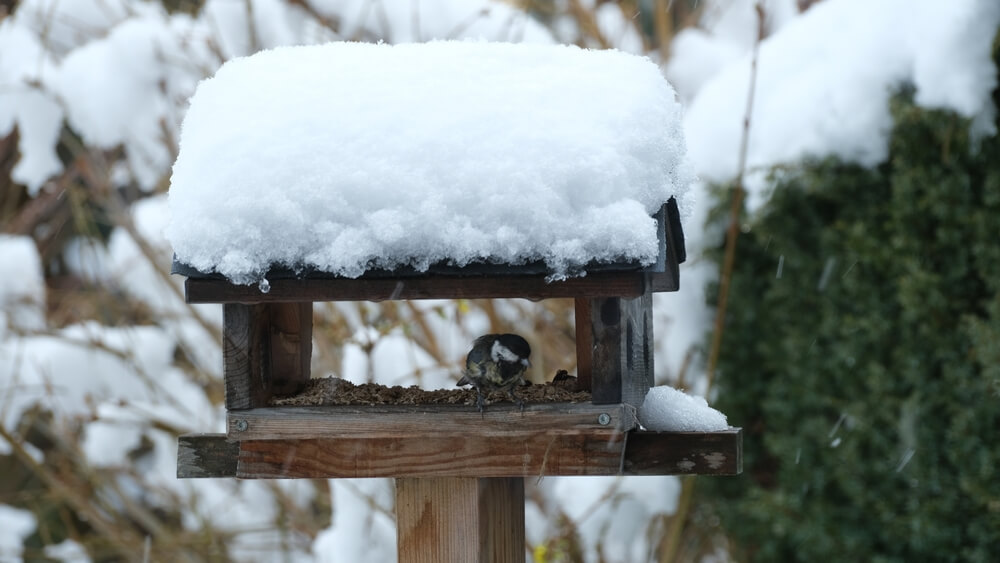We usually think of winter as a time when animals are scarce. They either hibernate unseen or migrate to warmer climates.
However, not all animals change their habits during the winter, including some birds. Certain species like to stick around in the same area for the whole year.
Of course, they still need to have a place to stay during the winter months.
Some birds do use birdhouses during the winter. These are mostly cavity nesters such as woodpeckers, chickadees, and nuthatches. Some cup nesters, like bluebirds, will also roost in a birdhouse during the winter. If you keep your birdhouse in shape, you can see birds all year round.

Birds That Don’t Migrate Use Birdhouses In The Winter

You may think that birds don’t need birdhouses in the winter because they migrate to warmer climates. But not every bird species migrates, or they only travel short distances if they do. And it rarely has anything to do with the climate.
In fact, many birds can survive just fine in freezing temperatures. It’s the lack of food and shelter materials that drives them to new locations each year.
Almost half of the 650 bird species in North America are non-migratory. Some common ones that stay in the same area throughout the year include:
- Corvids (crows, magpies, blue jays)
- Northern Cardinal
- Pigeons
- Doves
- Woodpeckers
- Northern mockingbirds
- Chickadees
- Mallards
- Turkey Buzzards
Types Of Birds That Use Birdhouses In Winter

Now, just because a bird stays in one area despite the cold, that doesn’t mean they need a birdhouse. Some, like turkey buzzards and mallards, are simply too large for a standard backyard birdhouse.
They also prefer nests that are on the ground or water or away from human activity.
There are still some permanent bird residents who will utilize a good birdhouse if they find one, though.
Cavity Nesters
Cavity nesters are the most common kind of bird that will use your birdhouse as a winter getaway.
These birds roost (sleep) and build nests in small holes in trees or abandoned animal burrows. The small hole of a birdhouse is perfect for them.
Here’s a short list of cavity nesters you might see this winter:
- Woodpeckers
- Nuthatches
- Chickadees
Cup Nesters
It’s not just cavity nesters who will accept shelter in your backyard. Some cup nesters may also take shelter provided by humans.
Cup nesters make the most recognizable form of nests. They literally look like small bowls or cups nestled in the branches of a tree.
However, the main purpose of a nest is to care for eggs and chicks. Outside of mating season, most birds don’t sleep in nests.
Instead, they “roost” wherever they feel safe and comfortable. Some birds, like ducks, may simply sleep floating on the water.
Others, like blue jays, will sleep in the crooks of trees or in dense vegetation like bushes. This keeps them safe from predators.
They may use a birdhouse, but it has to be an open-front design or a flat platform. They don’t like enclosed houses.
But bluebirds are more than happy to roost inside a birdhouse. They may even build a nest inside during mating season, provided there’s enough room.
3 Ways Birdhouses Help During The Winter

It’s a bird’s natural instinct to find or build a shelter for themselves in the wild.
So, what makes birdhouses so appealing to them?
1. Birdhouses Keep Birds Safe And Warm
Even though permanent resident birds can adapt to cold weather and limited food resources, they still need somewhere to sleep.
Birdhouses offer a quick and easy way for winter birds to protect themselves at night, not just from cold temperatures, but from wind, rain, and snow, as well as lurking predators.
2. Birds Can Spend More Energy Finding Food
Winter can be a hard time for birds. There’s less food available, so they have to work even harder to keep themselves fed.
They also have to worry about finding a good place to sleep at night. This can be a huge drain on their energy and affect their ability to find food.
By providing a birdhouse, you’re saving winter birds the trouble of having to find or build their own roosting places. Then, they can put their extra energy into finding all the food they need.
3. Birds Are Losing More And More Natural Habitat
It’s becoming harder and harder for birds to find not only nesting places, but a place to roost each night.
As human civilization expands, the natural habitats of birds and other animals unfortunately shrink.
But we can help bird populations recover by providing food and shelter in the form of feeders and birdhouses.
In fact, the eastern bluebird population was once in serious decline. In the past few decades, however, their numbers have been steadily increasing thanks to birdhouses.
5 Tips To Winterize A Backyard Birdhouse

It’s essential to create an environment that appeals to the birds you want to attract. This goes beyond just providing a basic birdhouse.
You have to make sure it offers enough protection and has food and water nearby.
Handy Tip: If you don’t already have a birdhouse, you can buy an easy DIY kit from your local hardware store. These require minimal tool and woodworking skills.
Follow these tips to prepare your backyard for visiting winter birds.
1. Clean And Repair The Birdhouse
If you have visitors to your birdhouse throughout the rest of the year, chances are they’ve left some mess behind.
Clean out any old nesting materials and droppings from previous tenants. Be sure to use gloves when handling droppings and feathers to avoid germs.
If there are any cracks or splinters in the birdhouse, fill and sand them away.
2. Seal And Insulate
Locate any (besides the entrance) and seal them up against the wind. You can use rags, weatherstripping, or even duct tape.
Use whatever will keep the inside nice and insulated. Birds aren’t picky about a house’s appearance!
3. Move To A High, Sunny Location
Like food and shelter, the sun is a scarce commodity in the winter. Find a place for your birdhouse that gets the most sunlight during the day.
Pay particular attention to where the sun hits in the afternoon. The warmer the box is at that time, the longer it will be warm when the sun goes down.
It’s also important to keep your birdhouse high off the ground. Birds feel safer higher up, and it protects them from hungry predators.
There’s nothing worse than finding that a cat or a raccoon has made a snack of your backyard birds.
Some of these predators are adept at climbing tree branches and fence posts. To keep your visiting birds safe, mount your birdhouse on a metal pole away from these areas.
4. Change The Entrance Hole (If Possible)
Some birdhouses have a front panel that you can remove and flip around. If your birdhouse has this feature, flip the front panel so the entrance hole is on the bottom.
This will reduce the heat loss through the hole since heat rises.
5. Keep Your Feeder And Fountain Well-Stocked
Although they’re not usually part of a birdhouse, birdfeeders and birdbaths are important resources for attracting backyard birds. You’ll have more success with your winter birdhouse if you also offer easy-access food and water.
First, determine what kind of birds winter in your area and offer their favorite food. Suet, sunflower seeds, and millet are good universal options.
Then, be sure to provide fresh, unfrozen water on a regular basis. Placing a plastic sheet at the bottom of your birdbath basin will make water and ice removal a breeze.
Just like with the birdhouse, a birdbath benefits from being in the sun as much as possible.
Handy tip: Put a plastic ball in the basin of your birdbath. The gentle bobbing of the ball will keep ice from forming!
Plastic birdbaths are a great option because they’re much more resistant to cracking than stone or glass. If you already have a birdbath that isn’t plastic, you should consider buying one just for the winter months.
Or, if you really want to pamper your birdies, buy a heated birdbath! These are a bit of an investment and do require an outdoor outlet. But your bird visitors will appreciate the spa-like experience.
Further reading: What To Put Inside A Birdhouse (Avoid These!)
To End
Not all birds fly south for the winter. In the US, there are several species of birds that are “permanent residents.” These include blue jays, chickadees, bluebirds, and some woodpeckers.
These birds still need shelter from the elements during this time. So they’re more than happy to take up residence in a backyard birdhouse.
Birdhouses are a great way to help animals in need and make your backyard a lively place this winter. By providing shelter, you’re taking that stress off the birds that don’t migrate.
Then, they can put their energy into finding food and other resources they need for the coming months. And you get to see a yard full of beautiful birds when things get cold and gray. That’s a win-win situation all around.












